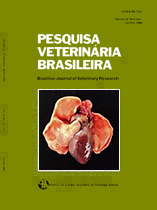 |
|
|
|
Year 2015 - Volume 35, Number 1001
|

|
Comparison among two methodologys at realization nitroblue tetrazolium reduction test (NBT) in caprines, 35(Supl.1):1-4
|
ABSTRACT.- Fonteque J.H., Saito M.E., Rizelo P.A., Teixeira W.T. & Kohayagawa A. 2015. [Comparison among two methodologys at realization nitroblue tetrazolium reduction test (NBT) in caprines.] Comparação entre duas metodologias para a realização do teste de redução do tetrazólio nitroazul (NBT) em caprinos. Pesquisa Veterinária Brasileira 35(Supl.1):1-4. Departamento de Medicina Veterinária, Hospital de Clínicas Veterinárias, Centro de Ciências Agroveterinárias, Universidade do Estado de Santa Catarina, Lages, SC 88520-000, Brazil. E-mail: fonteque@hotmail.com
The nitroblue tetrazolium reduction test (NBT) is one of the most used methods to evaluate the oxidative metabolism of neutrophils. However, the cost for each sample and dye’s life-time are disadvantages of the method. This paper aim was to compare two NBT test methodologies in order to maximize its use and decrease the cost for each sample. It was made using 10 adult and healthy goats and blood samples were taken through venipuncion in jugular vein, using 10mL tubes, and then a 500µL sample was taken in eppendoff tubes with 2µL of heparin. Using this sample were made three methodologies for the NBT test: A) Park & Good (1970) original technique; B) dye reduction in 50% of the volume; C) 50% reduction and dye storage at -20°C for 180 days. It was made and dyed the blood smear (May Grünwald-Giemsa) from the samples, using the proposed methodologies and then made the counting of 100 neutrophils in optic microscopy, to determinate the percentage of NBT reactive neutrophils. The statistic analysis by the method of Repeated Measuring Analysis (ANOVA) evinced significant differences (P<0,05) between the two methods and the original (A=14.4±4.6; B=1.9±1.4; C=1.1±0.9), however it showed high correlation by the Spearman test between the methods (rs=0,82 (AxB), rs=0,75 (BxC) e rs=0.93 (AxC)). It was concluded that the original Park & Good (1970) method and two methodologies for dye reduction in 50% and it’s reduction associated with NBT dye freezing for 180 days can be used in caprines, but the values should be compared with their respective methodologies. |
| |
|
|
| |
|
 |